Birds are a common and beloved sight in Pacifica, a coastal city in California. From the iconic seagulls that soar above the shoreline to the colorful songbirds that inhabit its many parks and woods, Pacifica is home to a variety of birds.
With its mild climate and abundant resources, Pacifica is an ideal habitat for a wide array of avian species. Whether you’re birdwatching on the beach or exploring its many parks, you can be sure to find a variety of birds that call Pacifica home.
1. White-Crowned Sparrow
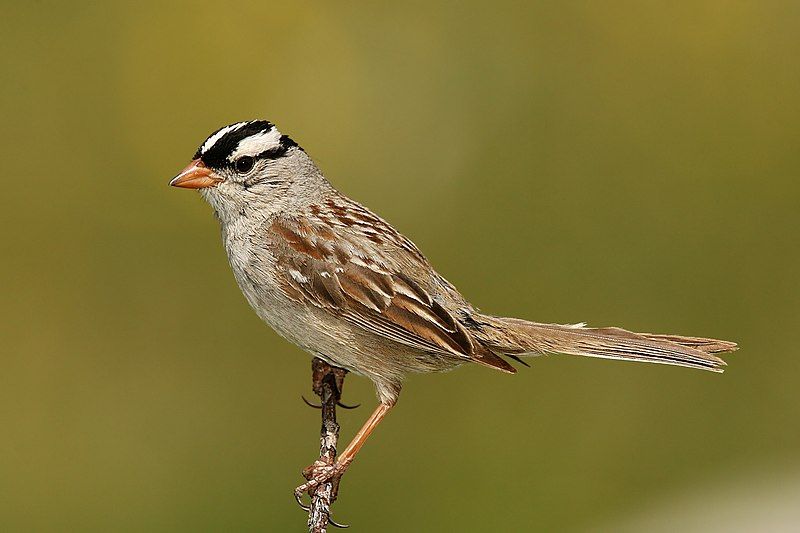
The white-crowned sparrow is a type of bird found in North America. It is a medium-sized bird, belonging to the New World sparrow family. It is easily distinguishable from other birds due to its distinctive grey face and black and white streaking on the upper head.
The streaking is said to be a way of signaling to other white-crowned sparrows that they are in its area. The white-crowned sparrow is a sociable bird that typically lives in forests, and can also be found in agricultural areas, parks, and gardens.
It has a wide range of vocalizations, including its famous song of alternating high and low notes. White-crowned sparrows are omnivorous, consuming both plant and animal matter.
They are known to be quite active during the day, often foraging for food and engaging in play activities. The white-crowned sparrow is a common sight across much of North America and is an important part of many local ecosystems.
| Kingdom | Animalia |
| Phylum | Chordata |
| Class | Aves |
| Order | Passeriformes |
| Family | Passerellidae |
| Genus | Zonotrichia |
| Species | Z. leucophrys |
2. California Gull
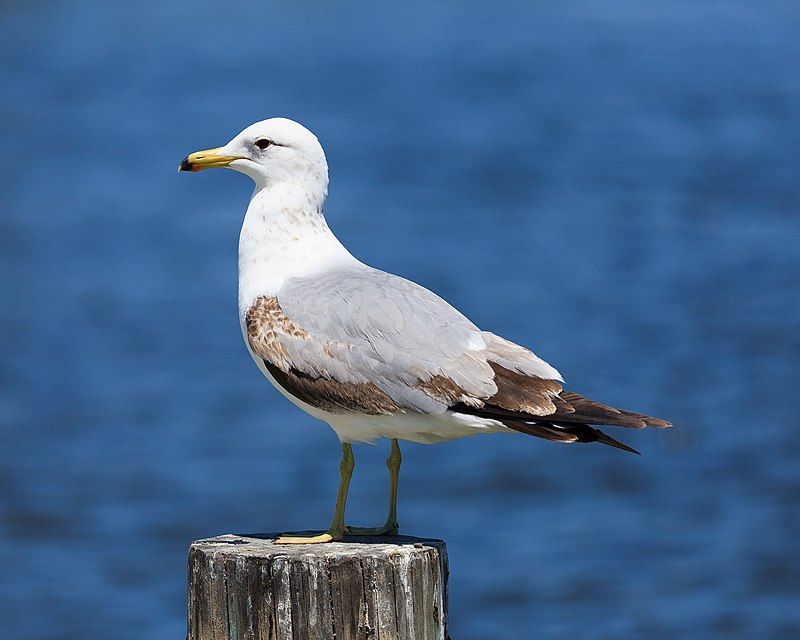
The California gull is a bird typically found on the western coast of North America. It is of medium size and is smaller in size than the herring gull, but larger than the ring-billed gull.
It is found not just in California, but up and down the entire western coast of North America, and also has breeding grounds inland. The California gull is easily identifiable by its yellow bill, which has a black ring around it.
This black ring is a distinguishing feature of this particular gull species, which sets it apart from other similar birds. The California gull is an important species in the ecosystem of the western coast and is an important part of the food chain for many other species.
The California gull has adapted to living in a wide variety of habitats, which makes it a resilient species that can survive in a diverse range of environments.
| Kingdom | Animalia |
| Phylum | Chordata |
| Class | Aves |
| Order | Charadriiformes |
| Family | Laridae |
| Genus | Larus |
| Species | L. californicus |
3. Common Goldeneye
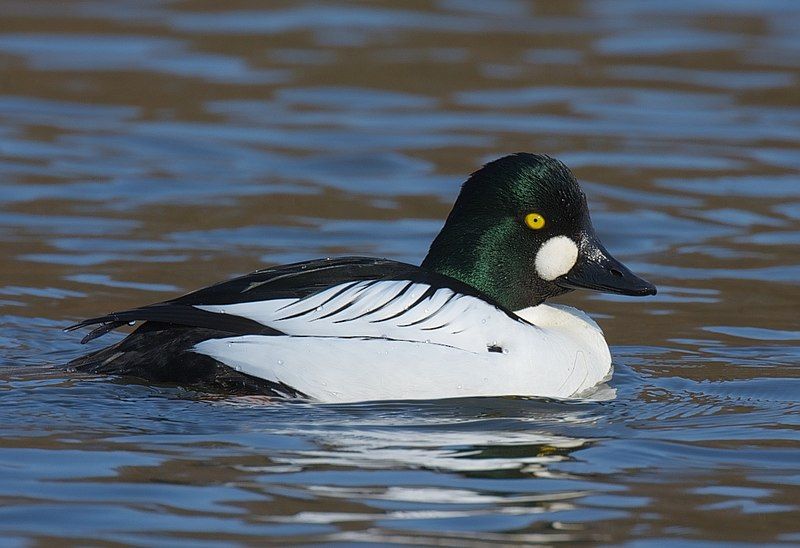
The common goldeneye is a sea duck belonging to the genus Bucephala, commonly known as the goldeneyes. This species is closely related to the Barrow’s goldeneye.
The genus name Bucephala is derived from the Ancient Greek boukephalos, a reference to the distinctive shape of the bufflehead’s head. This species is medium sized and has a beautiful iridescent appearance. The male has a black back, a white neck and chest, and a golden eye.
The female is more brownish and lacks the golden eye. Goldeneyes are found throughout North America and Europe, usually living near bodies of freshwater such as lakes and ponds.
They are expert swimmers and divers, using their wings to propel them underwater in search of their preferred diet of small fish and aquatic invertebrates. Goldeneyes are also known for their loud and distinct calls, which are audible from a long distance away.
| Kingdom | Animalia |
| Phylum | Chordata |
| Class | Aves |
| Order | Anseriformes |
| Family | Anatidae |
| Genus | Bucephala |
| Species | B. clangula |
4. Spotted Sandpiper
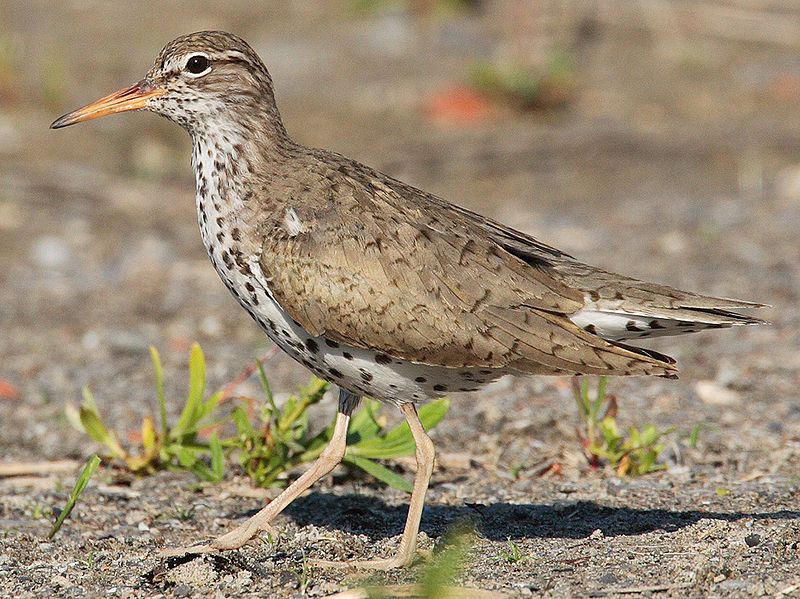
The spotted sandpiper is a small shorebird which belongs to the genus Actitis, along with its sister species the common sandpiper.
These two species can be found in different geographical regions, but occasionally birds from one species may move to an area where the other species is found and settle down with the breeders of the other species.
When this happens, the two species can hybridize, meaning that the offspring will possess genetic traits from both species.
Hybridization between the two species is more likely to occur when one species is more abundant than the other, as the birds will have a larger group of potential mates to choose from.
Hybridization can help the species to adapt to their changing environment, as the offspring may possess genetic traits which are better suited to their new home.
| Kingdom | Animalia |
| Phylum | Chordata |
| Class | Aves |
| Order | Charadriiformes |
| Family | Scolopacidae |
| Genus | Actitis |
| Species | A. macularius |
5. Ring-Necked Duck
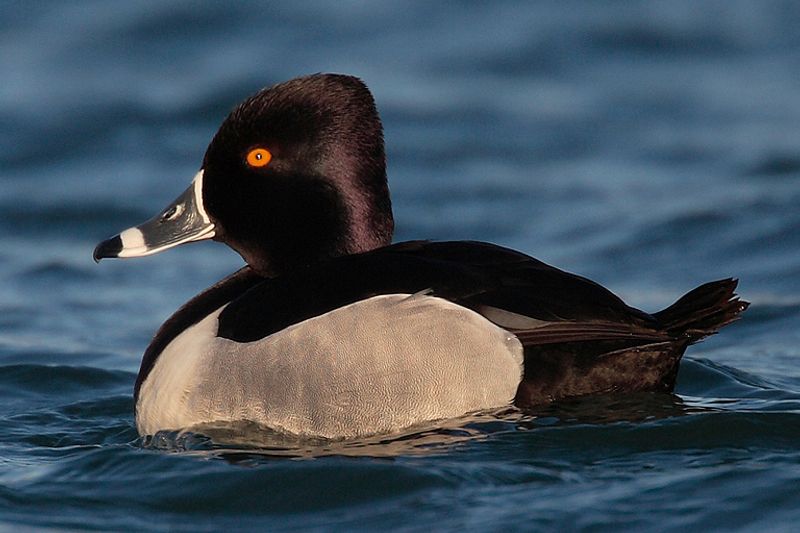
The Ring-necked Duck is a species of diving duck that is native to North America. It inhabits freshwater ponds and lakes and is identified by its distinctive white ring on the neck. The scientific name of this species is derived from two sources.
The first part, Aithuia, is derived from Greek and refers to an unidentified seabird mentioned by authors such as Hesychius and Aristotle. The second part of the name, collaris, is derived from Latin and means “of the neck” or “neck” from the Latin word collum.
This is in reference to the distinctive white ring found on the neck of the Ring-necked Duck. The scientific name of the Ring-necked Duck, therefore, is a nod to the bird’s distinctive feature.
| Kingdom | Animalia |
| Phylum | Chordata |
| Class | Aves |
| Order | Anseriformes |
| Family | Anatidae |
| Genus | Aythya |
| Species | A. collaris |
6. Whimbrel
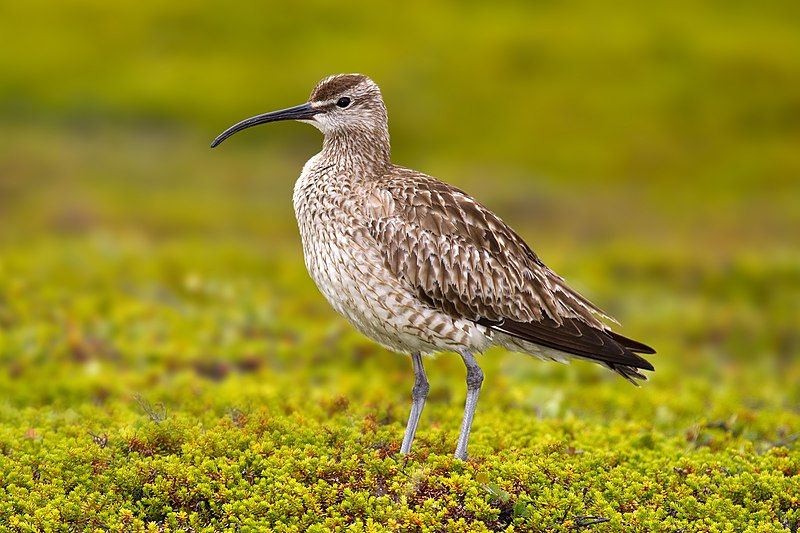
The Eurasian or common whimbrel is a type of wader found in the Scolopacidae family. It is one of the most common of the curlews, and is known as the white-rumped whimbrel in North America.
This species is found throughout much of subarctic Asia and Europe, and it even breeds as far south as Scotland. The Eurasian or common whimbrel is a medium-sized wader that has a long thin bill, mottled brown and white feathers, and a white rump.
It mainly inhabits coastal areas, where it feeds on small invertebrates and marine worms. The Eurasian or common whimbrel is migratory, and it travels between its breeding and wintering sites.
During the breeding season, it can be found in the tundra and bogs of northern Europe and Asia. In the winter, it migrates south to Africa, the Middle East, and India.
The Eurasian or common whimbrel is an important species for conservation, as it is threatened by habitat loss and overhunting.
The population is believed to have declined by about 30% since the early 2000s, as its coastal habitats are increasingly under threat due to human activities such as pollution and development.
| Kingdom | Animalia |
| Phylum | Chordata |
| Class | Aves |
| Order | Charadriiformes |
| Family | Scolopacidae |
| Genus | Numenius |
| Species | N. phaeopus |
7. Sanderling
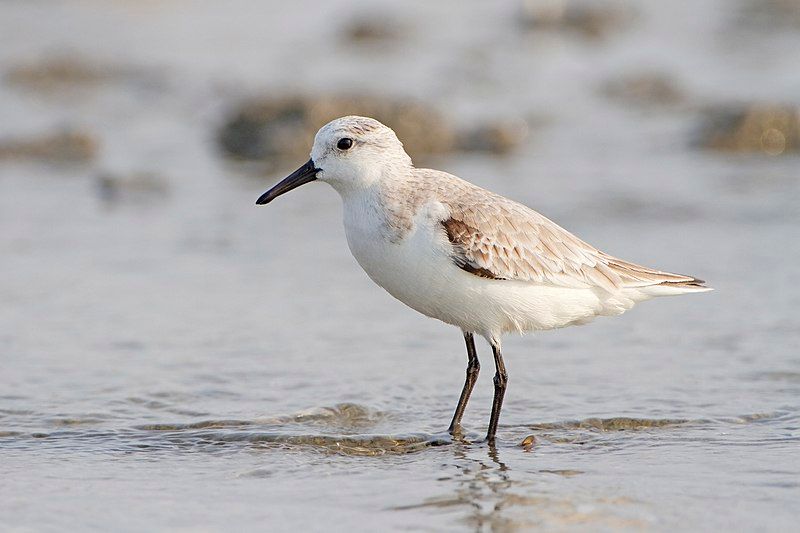
The sanderling is a small species of wading bird found in many parts of the world. Its name is derived from Old English, where sand-yrðling means “sand-ploughman”, likely referring to the sanderling’s habit of running along beaches in pursuit of its prey.
The genus name of the sanderling, kalidris or skalidris, was first used by the ancient Greek philosopher Aristotle to describe a group of grey-coloured birds found near bodies of water.
The species name of the sanderling, alba, is Latin for “white”, likely referring to its light-colored plumage. The sanderling is a fascinating species of bird that has an interesting origin story.
| Kingdom | Animalia |
| Phylum | Chordata |
| Class | Aves |
| Order | Charadriiformes |
| Family | Scolopacidae |
| Genus | Calidris |
| Species | C. alba |
8. Osprey
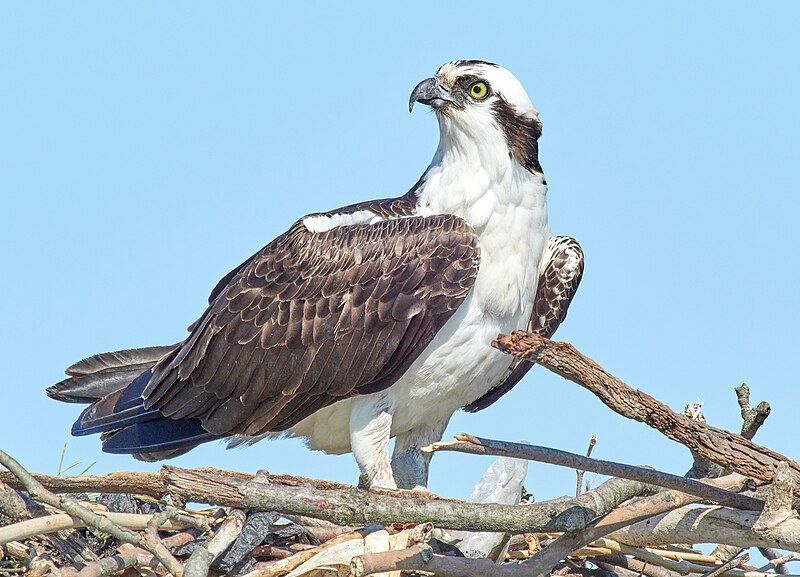
The osprey is a magnificent bird of prey, found on almost every single continent on Earth. It is also known by other names such as sea hawk, river hawk, and fish hawk. They are diurnal, meaning they are only active during the day, and they are also fish-eaters.
The size of an osprey can vary but they are generally quite large. They can reach a length of more than 60 cm and a wingspan of around 180 cm across. They have a distinct colouring: their upperparts are a brown colour while their head and underparts are mainly a greyish colour.
Ospreys can be seen in a variety of habitats such as near coasts, rivers and lakes. They can also be found in estuaries, marshes, and mangroves.
They are extremely well adapted to their environment, with long sharp talons and the ability to dive and catch their prey with amazing accuracy. Ospreys are a vital part of the ecosystem, and their numbers are decreasing due to habitat loss, pollution, and hunting.
It is important to protect the ospreys and their habitats so that future generations can enjoy their beauty and their importance to our environment.
| Kingdom | Animalia |
| Phylum | Chordata |
| Class | Aves |
| Order | Accipitriformes |
| Family | Pandionidae |
| Genus | Pandion |
| Species | P. haliaetus |
9. Western Sandpiper
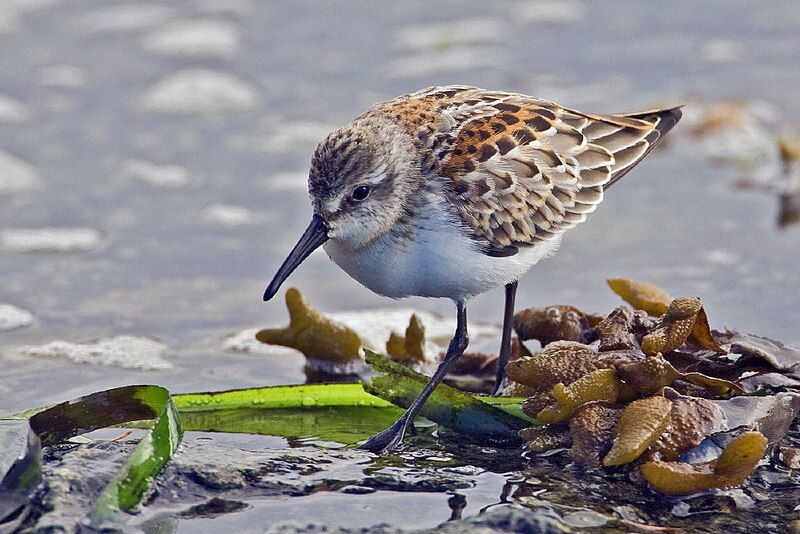
The western sandpiper is a small shorebird that is commonly found in the western hemisphere.
Its scientific name, Calidris mauri, is derived from Ancient Greek, specifically from the term kalidris or skalidris which was used by Aristotle to describe a type of grey-colored birds found near bodies of water.
The specific name mauri honors Italian botanist Ernesto Mauri, who was known for his work on plants and trees. This shorebird species is an important part of the ecosystem, providing food for larger animals and helping to maintain balance in the environment.
They often forage in shallow water and feed on invertebrates such as insects, crustaceans, and mollusks, which helps keep populations of these organisms in check.
The western sandpiper is also an important indicator species, as its presence or absence can tell us a lot about the overall health of a given environment.
| Kingdom | Animalia |
| Phylum | Chordata |
| Class | Aves |
| Order | Charadriiformes |
| Family | Scolopacidae |
| Genus | Calidris |
| Species | C. mauri |
10. Green-Winged Teal
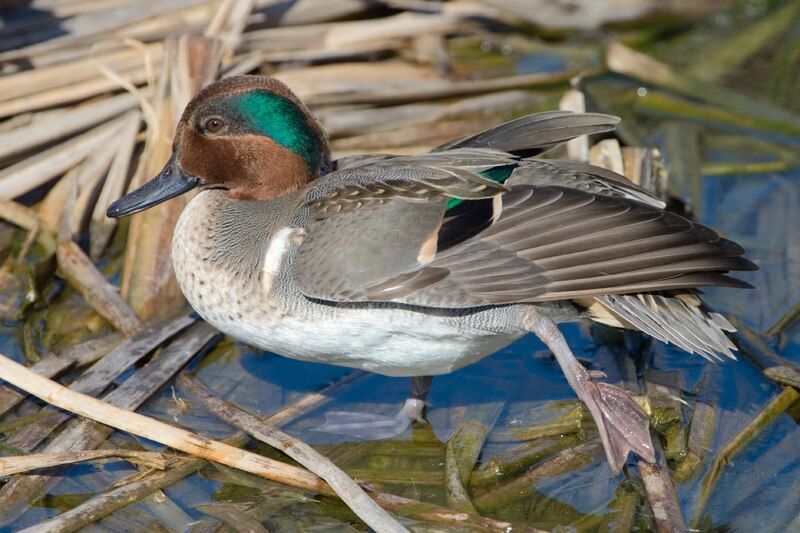
The American teal, or green-winged teal, is a species of duck which is found across much of North America. It is particularly common in the northern areas of the continent, with the exception of the Aleutian Islands.
The American teal was once thought to be the same species as the Eurasian teal, however they are now classified as separate species. The green-winged teal is easily identifiable due to its bright feathers and distinctive wing pattern.
It is also known for its rapid and agile flight, which is quite a sight to behold. This species of duck is an important part of the North American ecosystem, providing a food source for predators and helping to maintain healthy aquatic ecosystems.
| Kingdom | Animalia |
| Phylum | Chordata |
| Class | Aves |
| Order | Anseriformes |
| Family | Anatidae |
| Genus | Anas |
| Species | A. carolinensis |
11. Pectoral Sandpiper
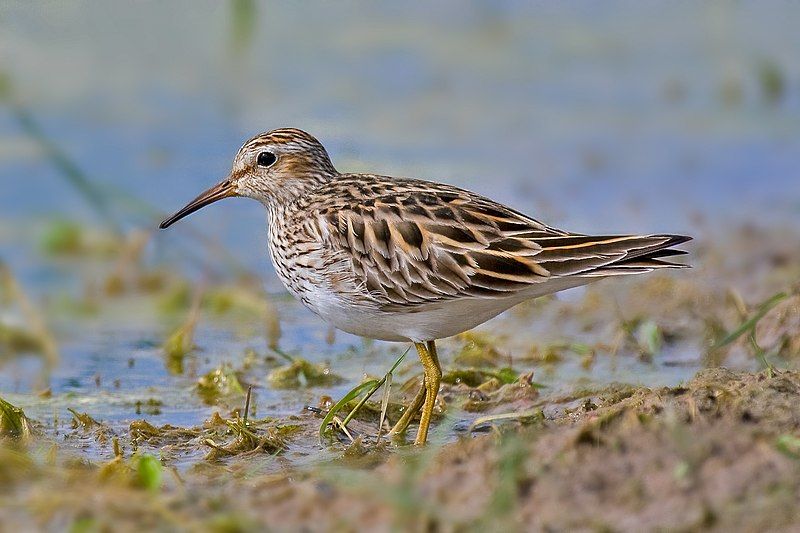
The pectoral sandpiper is a small bird that is migratory, meaning it lives in one area during one part of the year and then travels to another area for the other part of the year.
It breeds in North America and Asia in the warmer months and then winters in South America and Oceania in the cooler months. This bird eats small invertebrates, or animals without a backbone, as its main food source.
To provide protection for its eggs, the pectoral sandpiper builds a nest out of a hole scraped in the ground, and then lines it with thick material. This nest is deep enough to protect the four eggs from the cool breezes in its breeding grounds.
The pectoral sandpiper is an amazing species that relies on its natural habitat to survive, making it an important part of the environment.
| Kingdom | Animalia |
| Phylum | Chordata |
| Class | Aves |
| Order | Charadriiformes |
| Family | Scolopacidae |
| Genus | Calidris |
| Species | C. melanotos |
12. Ring-Billed Gull
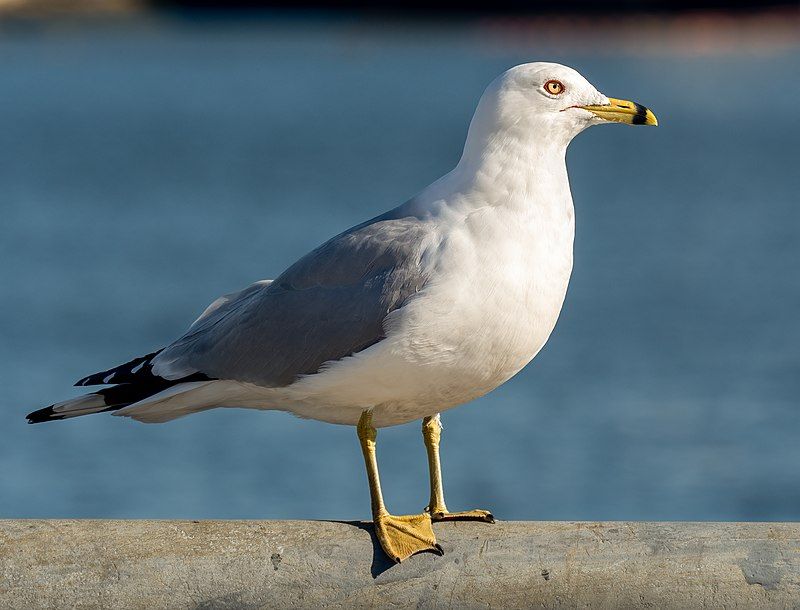
The Ring-billed Gull is a species of gull found in North America. It is a medium-sized gull, typically measuring between 16-18 inches in length and having a wingspan of up to 44 inches. Its scientific name is Larus delawarensis, which derives from Latin.
The genus name ‘Larus’ is thought to have been used to describe a large bird of the sea, such as a gull.
The specific epithet ‘delawarensis’ refers to the Delaware River, where the bird is known to inhabit.The Ring-billed Gull is a fairly common bird, found in many parts of North America.
It is a migratory species, with many of the birds leaving the southern parts of the continent for the winter months. The birds can be identified by their distinctive black ring around their bill, as well as a bright yellow eye.
They are omnivorous birds, feeding on a variety of items both in the water and on land, including fish, insects, seeds and small rodents.The Ring-billed Gull is an important species in its ecosystem, as it is a key predator of many aquatic organisms, including fish, amphibians and crustaceans.
It is also an important scavenger, helping to keep our beaches and waterways clean by eating dead animals and fish. The bird is also a popular species with birdwatchers, as it is fairly easy to find and observe.
| Kingdom | Animalia |
| Phylum | Chordata |
| Class | Aves |
| Order | Charadriiformes |
| Family | Laridae |
| Genus | Larus |
| Species | L. delawarensis |
13. Long-Billed Dowitcher
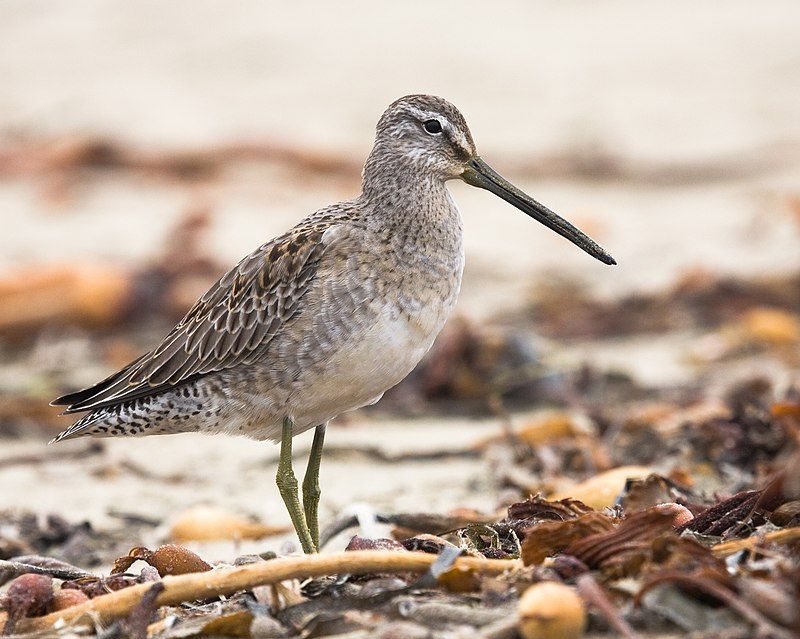
The long-billed dowitcher is a member of the sandpiper family, Scolopacidae, and is a medium-sized shorebird. It is easily identifiable by its long bill, which is more prominent than that of other shorebirds belonging to the same family.
In breeding plumage, adult long-billed dowitchers are distinguished by their attractive rufous head and underparts, as well as the darker mottled back. They also have a large white upper rump, which is only visible when the bird is in flight.
This combination of features makes the long-billed dowitcher an impressive and distinct shorebird species.
| Kingdom | Animalia |
| Phylum | Chordata |
| Class | Aves |
| Order | Charadriiformes |
| Family | Scolopacidae |
| Genus | Limnodromus |
| Species | L. scolopaceus |
14. Anna’s Hummingbird
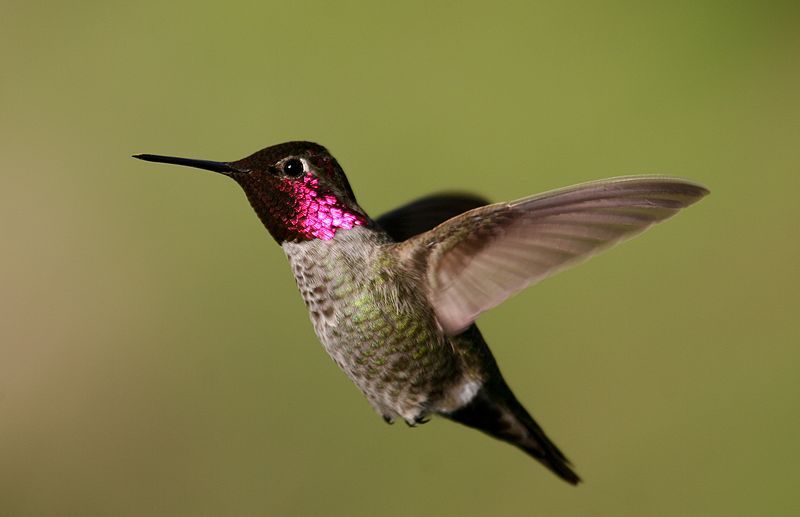
Anna’s hummingbird is a species of bird belonging to the family Trochilidae, which is also known as the hummingbird family. It was named after Anna Masséna, Duchess of Rivoli and is native to the western coastal regions of North America.
This species of hummingbird was once only found in the northern part of Baja California and in Southern California, but due to their adaptability and resilience, they have now spread throughout much of the western coast of the United States.
Anna’s hummingbirds are typically medium-sized birds with a wingspan of around 4-5 inches, and a body length of around 3 inches.
They are best known for their colorful plumage, which is typically a vibrant iridescent green on the head and back, and a paler green on the chest and belly. The male also has a distinctive red-orange throat patch, which is used to attract mates during the breeding season.
Anna’s hummingbirds are mainly found in open habitats, such as gardens, parks, and meadows. They primarily feed on nectar from flowers, as well as insects, and can often be seen hovering in mid-air as they feed.
They are known to be very territorial and will aggressively defend their feeding areas from other hummingbirds. Anna’s hummingbirds are also known to be incredibly agile in the air, and can reach speeds up to 30 mph while flying.
Anna’s hummingbirds are an important species in the western United States, as they are key pollinators of many native plants. They are also a popular species among birdwatchers, and are easily recognized by their distinctive red-orange throat patch.
| Kingdom | Animalia |
| Phylum | Chordata |
| Class | Aves |
| Clade | Strisores |
| Order | Apodiformes |
| Family | Trochilidae |
| Genus | Calypte |
| Species | C. anna |
15. Mallard
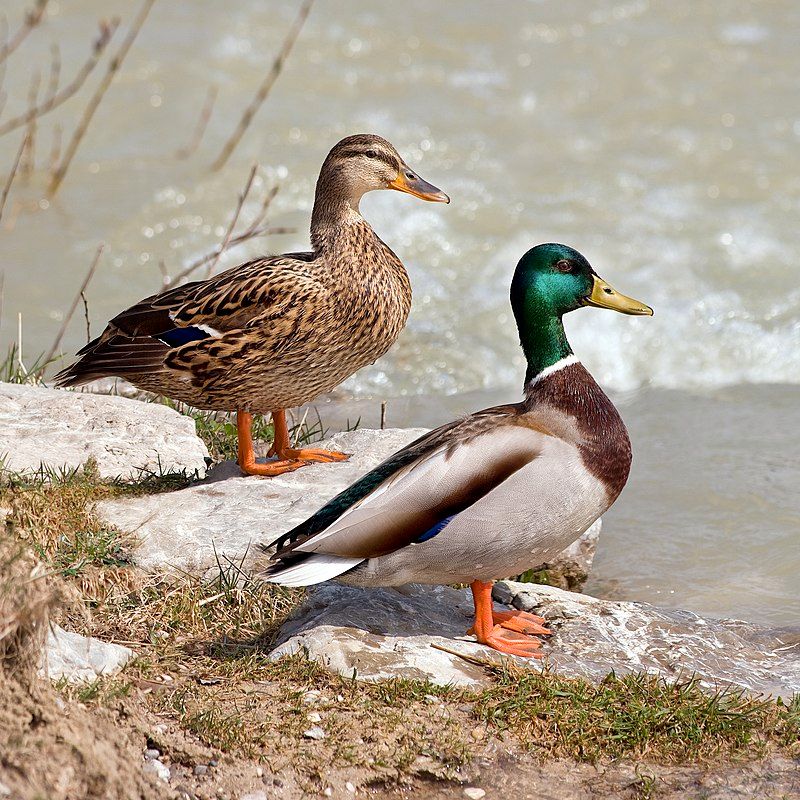
The mallard or wild duck is a species of dabbling duck that is widely distributed throughout the temperate and subtropical regions of the Americas, Eurasia, and North Africa.
This species has been introduced to many other regions of the world, including New Zealand, Australia, Peru, Brazil, Uruguay, Argentina, Chile, Colombia, the Falkland Islands, and South Africa.
As a dabbling duck, it typically feeds on the surface of the water, rather than diving to feed. This species can be easily identified by its characteristic brown and grey plumage, and its bright green head.
Mallards also have a distinct black and yellow bill, and they are well-known for their loud quacking call. This species is also the ancestor of many domestic duck breeds.
| Kingdom | Animalia |
| Phylum | Chordata |
| Class | Aves |
| Order | Anseriformes |
| Family | Anatidae |
| Genus | Anas |
| Species | A. platyrhynchos |
16. Gadwall
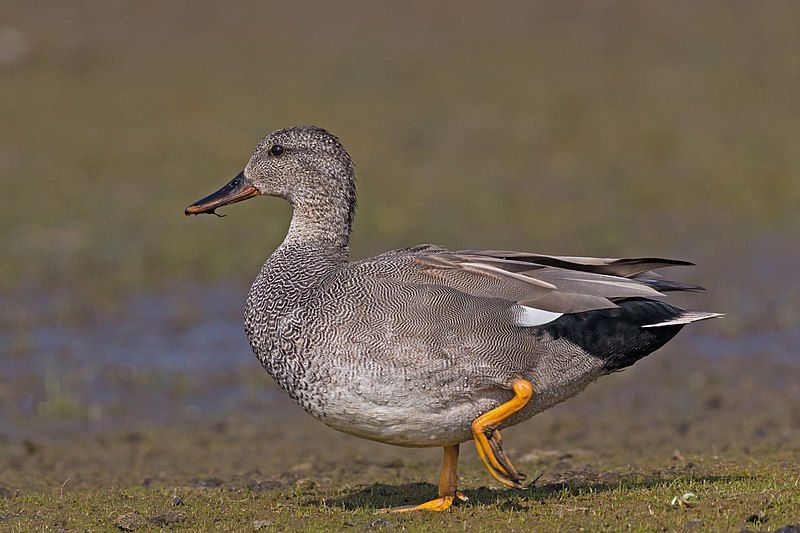
The gadwall is a species of dabbling duck, belonging to the family Anatidae. It is a medium-sized duck, with a body length of about 20 inches and a wingspan of around 32 inches.
The gadwall has a gray body with white patches on its wings and tail, and a black-and-white striped head.
It feeds mainly on aquatic invertebrates, such as insects, crustaceans, and mollusks, and also on plants.The gadwall is a widespread species, found in many parts of North America, Europe, and Asia.
It prefers wetland habitats such as marshes, ponds, and shallow lakes, though it can also be found in agricultural areas.
It is a highly migratory species, with some populations migrating several thousand miles to wintering grounds in the south.The gadwall is a social species, often forming large flocks. It is a fairly common species, with populations estimated to be in the millions.
It is also considered to be of least concern on the IUCN Red List of Threatened Species, with its numbers stable in most areas.
As a result, the gadwall is an important species in many wetland ecosystems, providing food for other animals and helping to maintain the balance of the food web.
| Kingdom | Animalia |
| Phylum | Chordata |
| Class | Aves |
| Order | Anseriformes |
| Family | Anatidae |
| Genus | Mareca |
| Species | M. strepera |
17. Red-Breasted Merganser
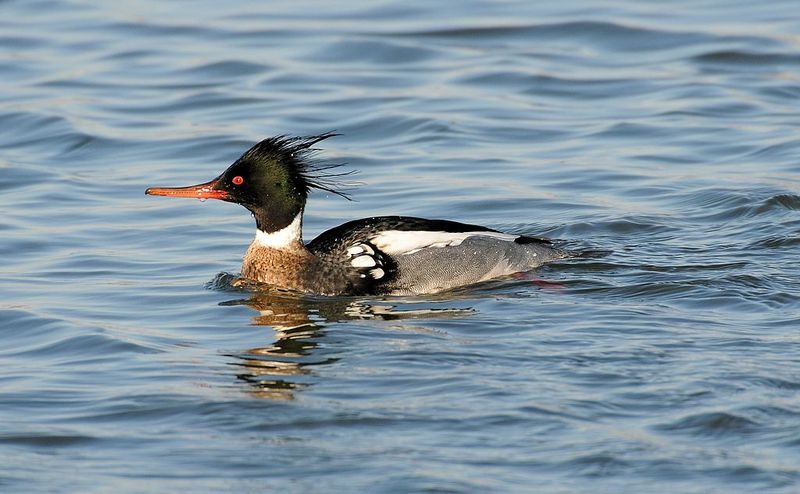
The red-breasted merganser is a species of duck that is found in many parts of the Northern Hemisphere. The males of this species have a distinctive reddish-brown breast, which is what gives the species its common name.
This red breast is only visible on males when they are in their breeding plumage. During this time, the males sport a colorful, glossy coating of feathers which helps them attract a mate.
The red-breasted merganser is an agile swimmer, and it often feeds on fish, aquatic insects, and other small creatures. The species is also known for its loud, raucous call which is one of the most distinctive sounds of the northern forests and wetlands.
| Kingdom | Animalia |
| Phylum | Chordata |
| Class | Aves |
| Order | Anseriformes |
| Family | Anatidae |
| Genus | Mergus |
| Species | M. serrator |
18. Ruddy Turnstone
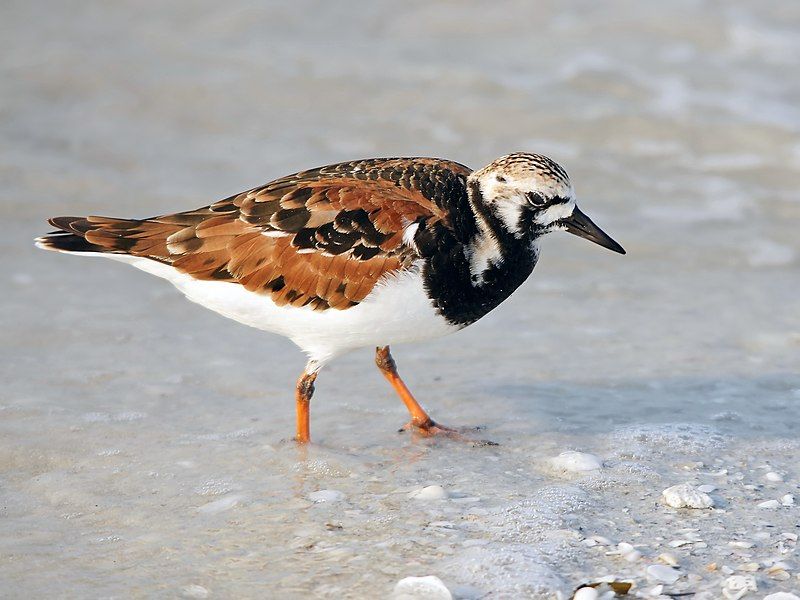
The Ruddy Turnstone is a small bird that is found around the world. It is part of the genus Arenaria and is classified as a sandpiper, which is part of the Scolopacidae family.
This classification was not always accurate, as it was sometimes mistaken for a plover, which belongs to the Charadriidae family. The Ruddy Turnstone is one of two species of turnstones, the other being the Black Turnstone.
The Ruddy Turnstone is small in size and has a unique reddish-brown plumage. It has a black face and chin, white belly, and black and white wings. Its legs are yellowish-orange and its bill is black with a yellow base.
It is often seen foraging on rocky beaches and mudflats, flipping stones with its bill in search of food. It feeds on a variety of small crustaceans, insects, and mollusks.
The Ruddy Turnstone is a migratory bird, found in coastal habitats in North America during the summer months and in Central and South America during the winter. It nests in colonies and makes its nest on the ground, usually on a cliff, beach, or dune.
It is threatened by human activities such as habitat destruction and disturbance, as well as hunting and egg collection.
| Kingdom | Animalia |
| Phylum | Chordata |
| Class | Aves |
| Order | Charadriiformes |
| Family | Scolopacidae |
| Genus | Arenaria |
| Species | A. interpres |
19. Great Blue Heron
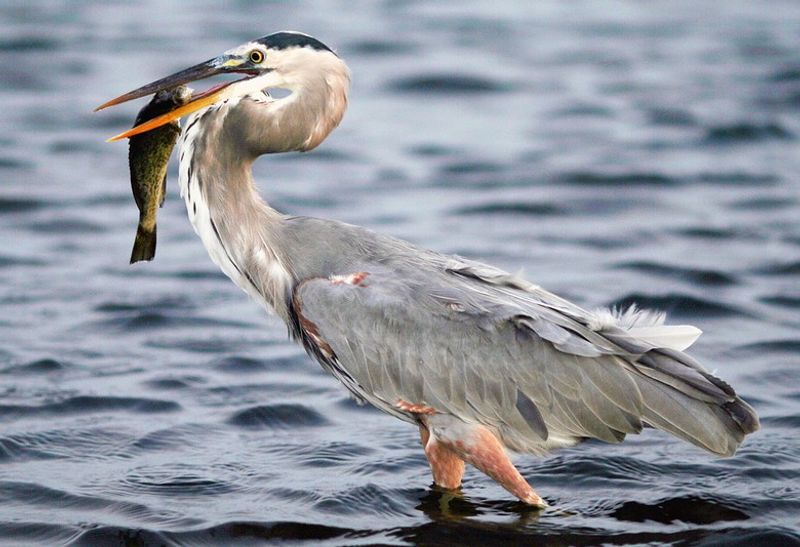
The great blue heron is a majestic bird that is found in many areas of the world. It is a large wading bird in the Ardeidae family, and is typically seen near bodies of open water and in wetlands.
Its range spans from North America, Central America, South America, the Caribbean, and the Galápagos Islands.
This wide-ranging species is an incredible migrator, and is known to cover vast distances in its travels.The great blue heron is a large bird, with a wingspan of up to 6 feet. It has a long neck, long legs, and a sharp, pointed bill.
It is typically a gray-brown color, with a white head and neck.
Its feathers are also flecked with black and white markings, and its legs are yellow.The great blue heron is a solitary bird, and can often be seen standing still in shallow water, waiting for fish or other aquatic creatures to come by.
It is an opportunistic feeder, and will take the chance to eat whatever it can find, including frogs, insects, and reptiles.
It also eats small mammals, such as mice and voles.The great blue heron is a majestic sight, and is a beautiful addition to any wetland or open water area. It is a great example of how diverse and fascinating the natural world can be.
| Kingdom | Animalia |
| Phylum | Chordata |
| Class | Aves |
| Order | Pelecaniformes |
| Family | Ardeidae |
| Genus | Ardea |
| Species | A. herodias |
20. Red-Necked Phalarope
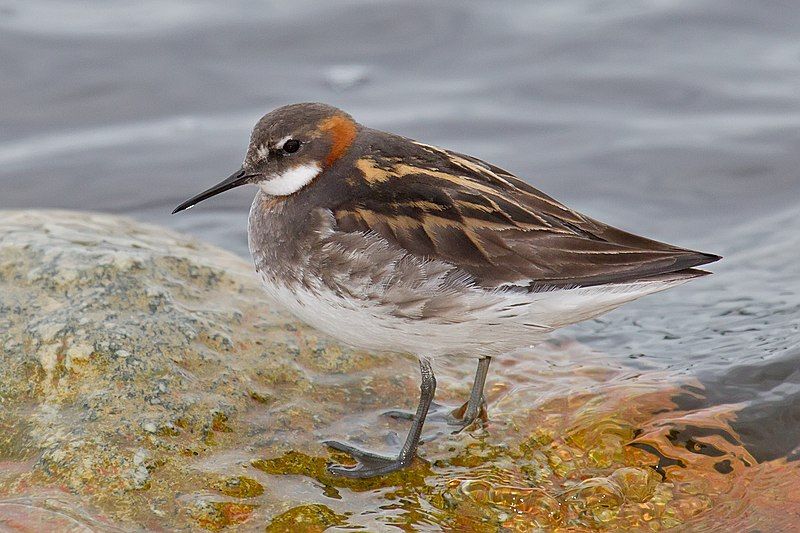
The red-necked phalarope, also known as the northern phalarope and hyperborean phalarope, is a small wader that belongs to the same family as the plovers and sandpipers. It is found in the Arctic regions of North America and Eurasia, where it breeds during the summer months.
The red-necked phalarope is a migratory species, and it spends the winter months at sea on tropical oceans.
This is unusual for a wader, as most species of waders migrate to warmer climates on land.The red-necked phalarope is a fairly small species, measuring around 16 cm in length and weighing around 45 g. Its upperparts are grey-brown, while its underparts are white.
The most distinctive feature of this species is the deep red patch on the neck and upper breast. It also has a dark eye-stripe and a thick black bill.The red-necked phalarope feeds mainly on invertebrates, such as insect larvae and small crustaceans.
It will also consume some plant material.
This species can often be seen spinning in circles on the water’s surface, a behaviour that it uses to disturb prey and make them more accessible.The red-necked phalarope is an important breeding species, with a steadily declining population.
Conservation efforts are needed to protect and restore this species’ population.
| Kingdom | Animalia |
| Phylum | Chordata |
| Class | Aves |
| Order | Charadriiformes |
| Family | Scolopacidae |
| Genus | Phalaropus |
| Species | P. lobatus |
21. Brant
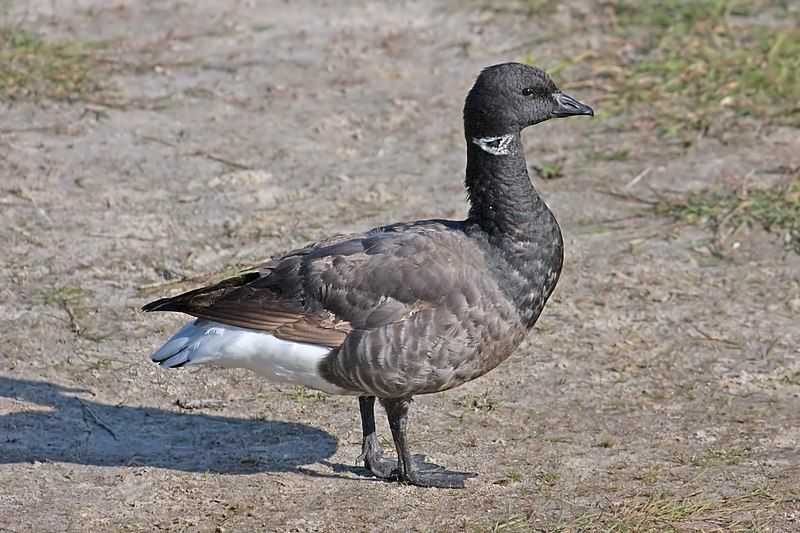
The brant or brent goose is a species of small goose that belongs to the genus Branta. There are three different subspecies of this goose, which spend their winters along temperate-zone coastlines and migrate to the Arctic tundra during the summer to breed.
This species of goose is so named because it was the inspiration for the naming of the Brent oilfield, which is located off the coast of Scotland. The Brent oilfield is the largest oil and gas field in the North Sea, and it is estimated to contain over 4 billion barrels of oil.
It was discovered in 1971 by Shell, and since then it has been an important source of oil for the region. The field was named after the brant or brent goose because of its proximity to the coastlines where the species winters.
The brant or brent goose is an important species in the region for a number of reasons. It is an important part of the Arctic ecosystem, and its presence helps to maintain the balance of the environment.
Additionally, the species is an important source of food for many other species of animals, including seabirds, seals, and other waterfowl.
Furthermore, the brant or brent goose is an important part of the culture in certain coastal communities, where it is seen as a source of good luck and fortune. The brant or brent goose is an important species in the region, and it is significant in many ways.
Its presence helps to maintain the balance of the environment, it is an important source of food for many other species, and it is a part of the culture in certain coastal communities.
The Brent oilfield is a testament to the species, as it was named after the brant or brent goose and serves as a reminder of the important role the species plays in the region.
| Kingdom | Animalia |
| Phylum | Chordata |
| Class | Aves |
| Order | Anseriformes |
| Family | Anatidae |
| Genus | Branta |
| Species | B. bernicla |
22. Buff-Breasted Sandpiper

Source: ebird.org
The buff-breasted sandpiper is a small shorebird that is part of the species Calidrid. Its scientific name is Subruficollis, which is derived from two Latin words – subrufus, meaning “reddish”, and collis, meaning “-necked/-throated”.
This refers to its reddish-brown color which is seen on its neck and throat. This species of sandpiper is found near wetlands and shorelines, and is known for its distinctive buff-colored chest and belly.
It is usually seen in migration, and can be found in places as far as South America and northern North America. This species is also known for its unique breeding behavior, in which both male and female take turns incubating the eggs and caring for the young chicks.
The buff-breasted sandpiper is an important part of the ecosystem, as it helps to control the populations of insects and other small invertebrates.
| Kingdom | Animalia |
| Phylum | Chordata |
| Class | Aves |
| Order | Charadriiformes |
| Family | Scolopacidae |
| Genus | Calidris |
| Species | C. subruficollis |
Conclusion
Birds in Pacifica are an integral part of the local wildlife, offering a unique connection to the environment and its residents.
From the majestic Bald Eagles to the small and colorful Hummingbirds, birds of all shapes and sizes can be found in Pacifica, providing beauty, joy, and a sense of connection to the natural world.
With the proper care and conservation, Pacifica’s birds can continue to be a source of wonder and inspiration for years to come.